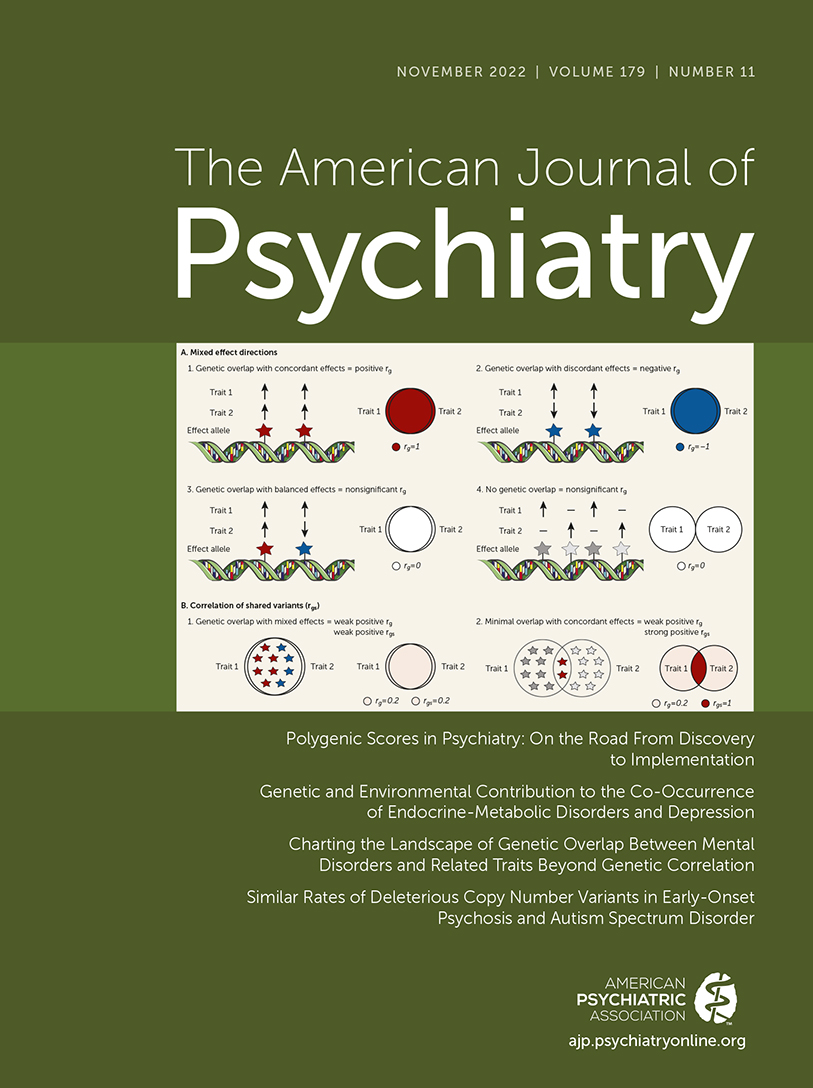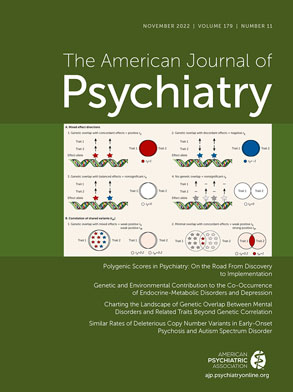Several biological, psychological, and behavioral factors have been proposed to influence the associations between these conditions, acting as mediating mechanisms in the causal relationships between depression and endocrine-metabolic diseases, and/or as common underlying factors affecting the risks of these conditions. Shared genetic influences could represent some of these common origins contributing to the development of such co-occurring disorders. This is known as genetic pleiotropy, when certain conditions or traits share genetic risk variants conferring a disposition for both disorders or traits in the same individual. Studies of families and twins have shown that genetic factors explain ∼40% of the phenotypic variation in liability for depression (
11), ∼40% for obesity (
12), 81% for T1D (
13), 72% for T2D (
14), between 38% and 71% for PCOS (
15), and ∼60% for both Hashimoto’s thyroiditis and Graves’ disease (
13). Growing evidence suggests genetic overlap between depression and some endocrine-metabolic disorders, in particular obesity (
16), T2D (
17), and PCOS (
4). This finding has been supported by a number of studies using molecular genetic data (
18–
20), while other investigations failed to replicate some of these results (
21,
22). The inconsistency in evidence is likely due to differences in disorder measurements, depression heterogeneity, and methodological approaches.
A greater understanding of the possible risk factors shared between these conditions is needed in order to elucidate potentially modifiable targets that could lead to tailored treatment strategies for individuals with co-occurring depression and different endocrine-metabolic disorders. Longitudinal population-based research using clinical diagnoses could help enlighten the etiological underpinnings of these conditions.
We investigated the familial coaggregation of clinically diagnosed depression and endocrine-metabolic disorders to test for the presence of shared familial liability, and we estimated the genetic and environmental contributions to the co-occurrence of these conditions using quantitative genetic modeling.
Discussion
In this nationwide register-based study of 2,263,311 individuals, we explored the associations between endocrine-metabolic disorders and depression using two complementary designs: familial coaggregation analysis and quantitative genetic modeling. To our knowledge, this is the largest sibling study investigating these associations and the first study to quantify and decompose the correlations between depression and T1D into genetic and environmental etiologies.
In line with previous research, we showed that individuals with endocrine-metabolic disorders were at increased risk of depression compared with the general population, especially for exposure to T2D, obesity, and hyperthyroidism (2.3–3.5 times higher odds), with males displaying elevated relative risks for the latter two compared to females’ relative risks. Full siblings of individuals with endocrine-metabolic disorders were also at higher risk of depression, suggesting that shared familial liability contributes to the co-occurrence of these conditions.
For the non-autoimmune endocrine-metabolic disorders (T2D, obesity, and PCOS), the shared familial liability was primarily due to genetics, with very small contributions from shared environmental factors, as suggested by the familial coaggregation analysis (i.e., the strongest associations with depression were found between full siblings, followed by maternal and paternal half siblings), and these findings were further supported by quantitative genetic modeling. Our results are consistent with previous studies suggesting shared genetic origins between depression and these conditions (
4,
16,
17), which is also reflected in the shared mechanisms linking these disorders (
36). For example, a number of common biological mechanisms have been proposed to explain the bidirectional depression-obesity link, including hyperactivation of the hypothalamic-pituitary-adrenal axis, immuno-inflammatory activation, and neuroendocrine system dysregulation (
6). These biological pathways may act as common underlying mechanisms influencing the liability to both depression and obesity, and/or as mediating factors in the causal link between the two conditions. Similar shared biological origins have been suggested to explain the bidirectional relationship between depression and T2D (
10). Intuitively, associations between obesity, T2D, and PCOS have also been established, all displaying common metabolic abnormalities such as insulin resistance (
37,
38). Overall, our findings suggest that similar etiologies for depression and comorbid obesity, T2D, and PCOS exist, and that family history may help identify risk factors for these co-occurring disorders. Furthermore, characterization and modification of upstream biomarkers of both depression and these non-autoimmune conditions could potentially prevent development of such chronic and debilitating illnesses. It is important to note that ∼30% of the phenotypic correlation between depression and non-autoimmune endocrine-metabolic disorders was attributable to environmental influences not shared between siblings. Behavioral and psychosocial factors such as sedentary lifestyle, poor nutrition, and poor sleep hygiene may represent some of these risk factors, which are accessible and modifiable, and which should remain key targets for prevention strategies and treatments of both depression and these endocrine-metabolic disorders. Some antidepressants have also been shown to influence the risk of obesity and T2D, although inconsistency of the evidence highlights the need for further investigation of the causal role of antidepressants in the development of these conditions (
10,
39).
In contrast, the phenotypic correlations between depression and autoimmune endocrine-metabolic disorders (autoimmune hypothyroidism and T1D), while not high (0.17 and 0.11, respectively), were largely explained by nonshared environmental factors. This was especially relevant in the association between T1D and depression, for which no evidence of shared genetic influences emerged. Our results are in line with a previous study, which found a weak genetic contribution to the co-occurrence of depression and autoimmune disorders using cross-trait polygenic risk score analyses and linkage disequilibrium score regression (
40).
This may reflect the existence of a direct link between these disorders via environmental mechanisms and/or causal environmental factors influencing the risk of both conditions. In accordance with emerging evidence, our study showed that although both T1D and T2D result in persistent hyperglycemia, their association with depression appeared to be driven by different underlying mechanisms. T1D usually has an earlier onset than T2D, with the potential to disrupt developmental processes during childhood and adolescence. Psychological mechanisms (e.g., parental stress and the burden of a lifelong disorder requiring a complex management regimen) as well as biological mechanisms (e.g., inflammation and cerebral damage) have been suggested to mediate the link between T1D and depression (
7).
From the quantitative genetic analyses, negative genetic and environmental contributions were observed for some phenotypes, for which there may be a number of possible reasons. For example, it is possible for a parameter whose true value is zero to be negative due to sampling error, which is particularly likely in smaller samples (
41). Another possibility is that such negative estimates actually reflect the underlying genetic or environmental mechanisms under investigation (
42,
43), for example, genes that have opposite effects on two phenotypes, or full-sibling cross-disorder correlations that are larger than the phenotypic correlations. Replication studies with larger sample sizes are needed.
Parental education level did not appear to influence the association and familial coaggregation of depression and endocrine-metabolic disorders; moreover, these findings were consistent in the quantitative genetic analyses, where we observed only a weak contribution of environmental factors shared between siblings (e.g., parental academic performance) to the co-presentation of these disorders.
Findings from the familial coaggregation analyses were consistent when comparing logistic and Cox regression models, indicating that there was no major difference when modeling the explored diagnoses as lifetime conditions or when considering time to diagnosis. Furthermore, similar results were obtained when depression was modeled as the outcome condition or as the exposure condition, suggesting a possible bidirectionality between the investigated disorders, but also encouraging caution when using diagnosis ordering to infer causality, since diagnostic records do not provide definitive information about when health problems occurred.
This study enhances our understanding of co-occurring depression and endocrine-metabolic disorders, and it underscores the importance of screening for comorbid symptoms in individuals with these conditions, which may lead to risk identification and early detection of concomitant conditions, as well as promotion of appropriate prevention and intervention strategies. Thus, collaboration between psychiatrists and endocrinologists should be prioritized in an effort to comprehensively manage both psychiatric and somatic conditions. Moreover, we present evidence of stronger shared genetic influences between depression and T2D, obesity, and PCOS compared with autoimmune disorders, suggesting different etiologies for these comorbid conditions and the need for tailored treatment strategies for individuals with depression and different comorbid endocrine-metabolic conditions.
This study had several limitations. Depression and endocrine-metabolic disorders treated within primary care could not be captured, possibly limiting the generalizability of the findings to the more severe clinical cases, as well as to treatment-seeking individuals. Yet, diagnoses given to children and adolescents are well captured in the National Patient Register, as it is standard for these patients to be referred to specialist health care for these conditions.
Exposure to T1D and T2D could have been misclassified, since ICD-8 and ICD-9 did not distinguish between the two types. Nevertheless, we were able to minimize this issue by restricting T1D measures to individuals with a diagnosis of diabetes before age 19, given that the majority (98%–99%) of Swedish children diagnosed with diabetes at 0–18 years of age have been shown to have T1D (
44). Since the maximum age at the end of follow-up was 40 years, we could investigate only early-onset forms of T2D, autoimmune hypothyroidism, and Graves’ disease, which could represent more heritable forms of these disorders and therefore may explain why we found stronger genetic contributions to these disorders compared to a previous study using linkage disequilibrium score regression (
45). Similarly, we defined obesity using clinical diagnoses rather than BMI measures, potentially capturing a more serious form of the disorder, which could explain the increased heritability estimated in this study compared with previous research (
45,
46). Moreover, depression heterogeneity could have hampered the results, since the explored associations are likely to vary in different subgroups of patients. Further research is needed to investigate the role of age at onset of depression, symptom profiles, severity, depression history, and other psychiatric comorbidities.
Given the low power in our quantitative genetic analyses, caution in interpretation of the genetic and environmental correlations is warranted, and replication studies with increased sample sizes are encouraged. Furthermore, one key assumption of quantitative genetic analyses is that there are no correlations or interactions between genes and environment (
47). As a consequence, estimates may be biased if this assumption does not hold. Future research assessing gene-environment interplay will be important to gain further insights into the etiology of depression and endocrine-metabolic disorders.
When investigating the possible role of socioeconomic status, we performed our analyses across different parental education levels; given that academic performance has been shown to be moderately heritable and correlated with offspring education (
48), there is a risk that adjusting for parental educational attainment could lead to biased estimates (e.g., by conditioning on a collider). Finally, although we found no evidence of a major effect of socioeconomic status in the explored associations, it is important to note that parental educational attainment may inadequately capture the complexity of socioeconomic status.
In summary, we presented convergent evidence from two methods, supporting knowledge from previous research on the comorbidity between depression and various endocrine-metabolic disorders and providing new insights into the etiological sources of their co-occurrence. We reported considerable shared genetic influences between depression and non-autoimmune endocrine-metabolic disorders, and limited common genetic factors between depression and autoimmune disorders, particularly T1D. Our results encourage clinical vigilance for co-presentation of endocrine-metabolic disorders and depression, providing a useful foundation for future research aimed at characterizing and targeting the underlying biological mechanisms and modifiable risk factors.




